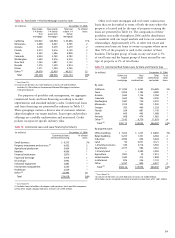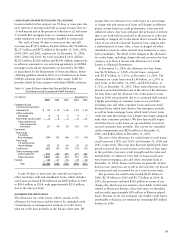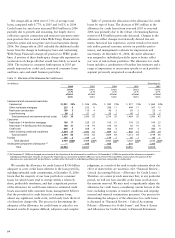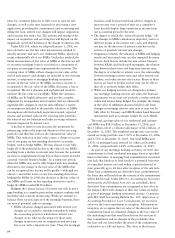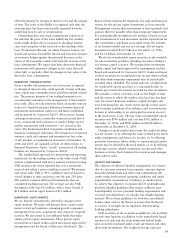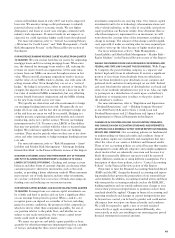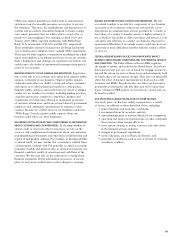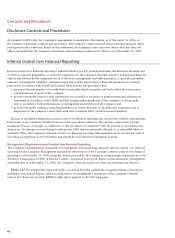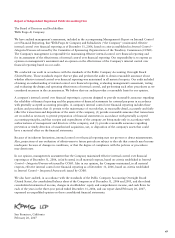Wells Fargo 2006 Annual Report Download - page 61
Download and view the complete annual report
Please find page 61 of the 2006 Wells Fargo annual report below. You can navigate through the pages in the report by either clicking on the pages listed below, or by using the keyword search tool below to find specific information within the annual report.
59
WELLS FARGO FINANCIAL. In January 2006, Wells Fargo
Financial Canada Corporation (WFFCC), a wholly-owned
Canadian subsidiary of Wells Fargo Financial, Inc. (WFFI),
qualified for distribution with the provincial securities
exchanges in Canada $7.0 billion (Canadian) of issuance
authority. During 2006, WFFCC issued $1.6 billion
(Canadian) in senior notes. At December 31, 2006, the
remaining issuance capacity for WFFCC was $5.4 billion
(Canadian). WFFI also issued $450 million (U.S.) in private
placements in 2006.
Comparison of 2005 with 2004
Net income in 2005 increased 9% to a record $7.67 billion
from $7.01 billion in 2004. Diluted earnings per common
share increased 10% to a record $2.25 in 2005 from $2.05
in 2004. Our earnings growth in 2005 from 2004 was broad
based, with nearly every consumer and commercial business
line achieving double-digit profit growth, including regional
banking, wealth management, corporate trust, business
direct, asset-based lending, student lending, consumer credit,
commercial real estate and international trade services. Both
Capital Management
We have an active program for managing stockholder capital.
We use capital to fund organic growth, acquire banks and
other financial services companies, pay dividends and repur-
chase our shares. Our objective is to produce above-market
long-term returns by opportunistically using capital when
returns are perceived to be high and issuing/accumulating
capital when such costs are perceived to be low.
From time to time the Board authorizes the Company
to repurchase shares of our common stock. Although we
announce when the Board authorizes share repurchases, we
typically do not give any public notice before we repurchase
our shares. Various factors determine the amount and timing
of our share repurchases, including our capital requirements,
the number of shares we expect to issue for acquisitions and
employee benefit plans, market conditions (including the
trading price of our stock), and legal considerations. These
factors can change at any time, and there can be no assur-
ance as to the number of shares we will repurchase or when
we will repurchase them.
Historically, our policy has been to repurchase shares
under the “safe harbor” conditions of Rule 10b-18 of the
Exchange Act including a limitation on the daily volume of
repurchases. Rule 10b-18 imposes an additional daily volume
limitation on share repurchases during a pending merger or
acquisition in which shares of our stock will constitute some or
all of the consideration. Our management may determine that
during a pending stock merger or acquisition when the safe
harbor would otherwise be available, it is in our best interest
to repurchase shares in excess of this additional daily volume
limitation. In such cases, we intend to repurchase shares in
compliance with the other conditions of the safe harbor,
including the standing daily volume limitation that applies
whether or not there is a pending stock merger or acquisition.
In 2005, the Board authorized the repurchase of up to
150 million additional shares of our outstanding common
stock. In June 2006, the Board authorized the repurchase of
up to 50 million additional shares of our outstanding common
stock. During 2006, we repurchased 59 million shares of our
common stock. At December 31, 2006, the total remaining
common stock repurchase authority was 62 million shares.
On June 27, 2006, the Board declared a two-for-one
stock split in the form of a 100% stock dividend on our
common stock which was distributed August 11, 2006, to
stockholders of record at the close of business August 4, 2006.
We distributed one share of common stock for each share of
common stock issued and outstanding or held in the treasury
of the Company. Also, in June 2006, the Board declared an
increase in the quarterly common stock dividend to 56 cents
per share, up 4 cents, or 8%. The cash dividend was on a
pre-split basis and was payable September 1, 2006, to stock-
holders of record at the close of business August 4, 2006.
Our potential sources of capital include retained earnings
and issuances of common and preferred stock. In 2006, retained
earnings increased $4.7 billion, predominantly as a result
of net income of $8.5 billion less dividends of $3.6 billion.
In 2006, we issued $2.1 billion of common stock (including
shares issued for our ESOP plan) under various employee
benefit and director plans and under our dividend reinvest-
ment and direct stock purchase programs.
The Company and each of our subsidiary banks are
subject to various regulatory capital adequacy requirements
administered by the Federal Reserve Board and the OCC.
Risk-based capital guidelines establish a risk-adjusted ratio
relating capital to different categories of assets and off-balance
sheet exposures. At December 31, 2006, the Company and
each of our covered subsidiary banks were “well capitalized”
under applicable regulatory capital adequacy guidelines. See
Note 25 (Regulatory and Agency Capital Requirements) to
Financial Statements for additional information.
net interest income and noninterest income for 2005 grew
solidly from 2004 and virtually all of our fee-based products
had double-digit revenue growth. We took significant actions
to reposition our balance sheet in 2005 designed to improve
yields on earning assets, including the sale of $48 billion of
our lowest-yielding ARMs, resulting in $119 million of sales-
related losses, and the sale of $17 billion of debt securities,
including low-yielding fixed-income securities, resulting in
$120 million of losses.




